Zoology
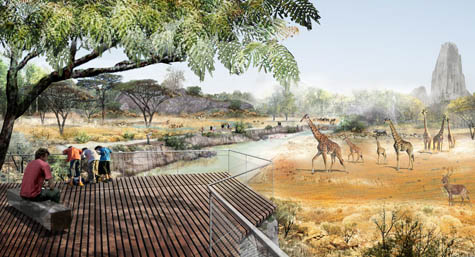 [Image: The future Zoo de Vincennes by TN PLUS Landscape Architects, with additional architecture by Beckmann N'Thepe].
[Image: The future Zoo de Vincennes by TN PLUS Landscape Architects, with additional architecture by Beckmann N'Thepe].A few months ago we took a look at plans for a new zoo in Vincennes, France, being developed by landscape architects TN PLUS. I've since been in touch with the firm, who have sent in more images of the proposed landscape. I thought I'd post them here, then, even as I also refer everyone back to the earlier post.
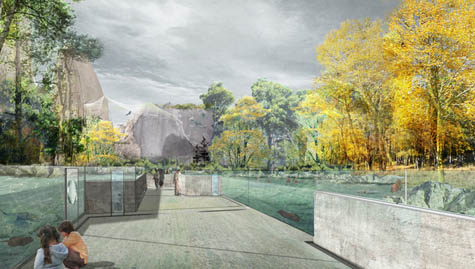 [Image: The Zoo de Vincennes by TN PLUS Landscape Architects].
[Image: The Zoo de Vincennes by TN PLUS Landscape Architects].I have to register my fascination again, however, with the idea that zoos actually represent a kind of spatial hieroglyphics through which humans communicate – or, more accurately, miscommunicate – with other species.
That is, zoos are decoy environments that refer to absent landscapes elsewhere. If this act of reference is read, or interpreted correctly, by the non-human species for whom the landscape has been constructed, then you have a successful zoo. One could perhaps even argue here that there is a grammar – even a deep structure – to the landscape architecture of zoos.
Zoos, in this way of thinking, are at least partially subject to a rhetorical analysis: do they express what they are intended to communicate – and how has this meaning been produced?
Landscape architecture becomes an act not just of stylized geography, or aesthetically shaped terrain, but of communication across species lines.
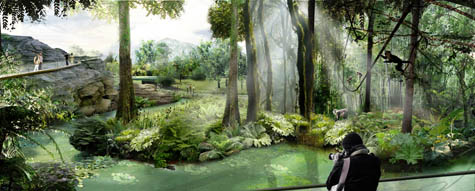
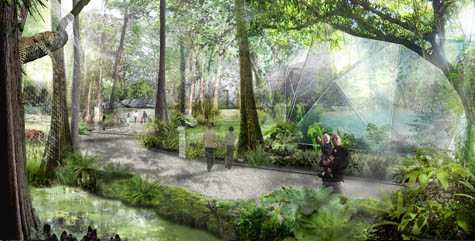 [Images: The Zoo de Vincennes by TN PLUS Landscape Architects].
[Images: The Zoo de Vincennes by TN PLUS Landscape Architects].Of course, this can also be inverted: are these landscapes really meant to be read, understood, and interpreted by what we broadly refer to as "animals," or are these landscapes simply projections of our own inner fantasies of the wild? Or should I say The Wild?
While this latter scenario sounds much more likely to be the case – humans, like a broken cinema, always live inside their own projections – nonetheless, the non-human communicational possibilities of landscape architecture will continue to fascinate me.
 [Image: The Zoo de Vincennes by TN PLUS Landscape Architects].
[Image: The Zoo de Vincennes by TN PLUS Landscape Architects].In fact, briefly, I'm reminded of two things:
- 1) Fritz Haeg's Animal Estates initiative, in which small homes for animals are constructed to house the native, pre-human population of urban landscapes around the world. Haeg explains that he "creates dwellings for animals," and that these "prototype Animal Estates will be established in a variety of environments. (...) Each will be designed to attract and welcome a particular animal back into an environment that has been dominated by humans. The design for each estate will be developed with a local specialist on that particular animal."
2) Temple Grandin, who could perhaps be described as an autistic animal theorist. Grandin has been campaigning for the re-design of slaughterhouse environments in order that they be less terrifying for animals; but what's particularly interesting about her campaign is that – if I've understood this correctly – she has extrapolated from her own subjective experiences of autism in order to model how animals might experience slaughterhouse architecture. Human autism here becomes strangely elided with animal subjectivity. Grandin has thus developed an entire phenomenological architecture that takes advantage of natural animal behaviors – circling, herding, grouping, and so on – by spatializing these behaviors into the built environment. Animal movements trace out spatial parameters that the architecture itself later takes. The animals are thus doing what they would have been doing "naturally" as they enter the spinning blades...
To put even more of an academic spin on this, zoos are speech acts.
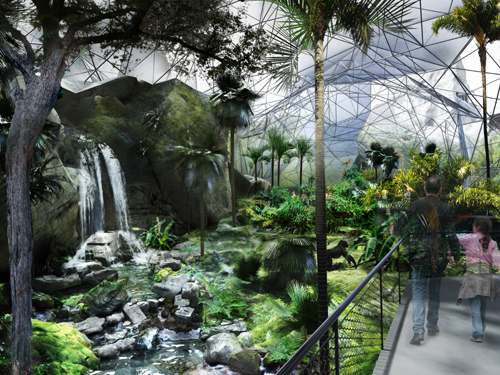 [Image: The Zoo de Vincennes by TN PLUS Landscape Architects].
[Image: The Zoo de Vincennes by TN PLUS Landscape Architects].But I've said much the same before; check out the earlier post for more.





Comments are moderated.
If it's not spam, it will appear here shortly!
I am more inclined to side with Adorno in his interpretation of zoos from Minima Moralia, which argues, among other things, that to "preserve" a species is to acknowledge that you have already destroyed it.
Here are some fragments from Aphorism 74, "Mammoth": "The use of zoos for entertainment and instruction seems to be a thin pretext. They are allegories of the possibility that a specimen or a pair can defy the doom which befalls the species as a species....The more invisible the boundaries become, the more completely the freedom of the creatures is repudiated, whose gaze could be ignited by the longing for the wide distance....The more that civilization preserves and transplants unspoiled nature, the more implacably the latter is controlled...."
Overall, zoos and slaughterhouses have a lot in common, and the (mistaken) notion that either can be "humane" is one of the commonalities. I would argue that both "environments" are organized far more effectively around human subjectivity than animal subjectivity. While Temple Grandin may design slaughterhouses to be more humane, her designs will be taken up by meat producers for a different, human, reason: the more placid the animal, the easier the slaughtering process is for the slaughterers.
Part of the reason for Grandin's designs also - adrenaline floods muscles quickly. Adrenaline tastes bad. Calm killings taste better.
Similar questions of emotion flavors
here.
"That is, zoos are decoy environments that refer to absent landscapes elsewhere. If this act of reference is read, or interpreted correctly, by the non-human species for whom the landscape has been constructed, then you have a successful zoo."
now substitute "earth" for "zoo" and "human" for "non-human," and you've plagiarized the intergalactically reknowned kxbyxti 'human habitat creation theory' manual.
Temple Grandin is best described as *Doctor* Grandin:
"[Dr. Grandin] obtained her B.A. at Frankin Pierce College and her M.S. in Animal Science at Arizona State University. Dr. Grandin received her Ph.D in Animal Science from the University of Illinois in 1989. Today she teaches courses on livestock behaviour and facility design at Colorado State Univeristy and consults with the livestock industry on facility design, livestock handling, and animal welfare.[..]"
Zoos are cages. A beautiful cage that looks like the savannah or whatever is still a cage. Zoos are also interesting repositories for genetic material. They're the seed banks of the animal kingdom.
There is a fascinating section of Oliver Sach's book, An Antropologist on Mars about Dr. Grandin. In particular, he describes this, for lack of a better word, "hugging machine" that she designed and uses. It seems that her autism keeps her from appreciating much human contact but that she enjoys the "closed in" feeling of this machine. At least that's how I remember it, it's been a long time since I read it. Perhaps her own mechanical means of comfort have made their way into her architecture of slaughterhouses.
Hey Kevin - I should get one of those hugging machines... So I've been wanting to talk to Oliver Sacks about the neurology of spatial perception, actually; maybe this will inspire me to try to make that happen. For an interview.
And while I agree that zoos are really just large cages, the crucial detail is that they have been stylized - they aren't literally just bars and concrete (in most cases). It's in this act of stylization - an act of landscape design - that you get into issues of duplicity, reference, simulation, trans-species communication, and so on. You are building an environment whose purpose is to blur the line between artificial and natural in the eyes of the animals who will then be using that environment.
Of course, a "human habitat creation" manual could also come in handy for such a discussion...
Why are the renderings always shown from the human side and not the animals' view??
Ron Moss, Architect
You're very close to understanding Dr. Grandin's work, but you're a little off. Her essential nature as an autistic doesn't grant her magical powers to understand the feelings of animals. Nor would she or anyone else claim that animals feel what autistics feel - or vice versa.
Dr. Grandin has studied, though careful note-taking, observation and research, the things that upset livestock, as well as things that seem to calm them. All of the changes that she's suggested were based on work that anyone could have done.
Where her autism comes into play is in motivating her to be concerned with animals because like many autistics they cannot speak for themselves, and through experiences that inform her understanding of how it feels to be confused, isolated, and unable to express her feelings. Autism hasn't made her a magical "cow whisperer" or anything - but it has motivated her to listen and care about the needs of animals.
Post a Comment